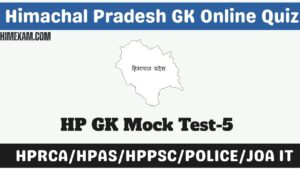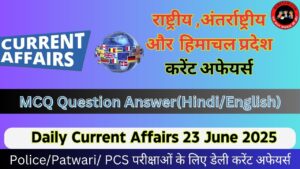Movement in Himachal Pradesh before independence In English
||Movement in Himachal Pradesh before independence In English||Movement in HP before independence In English||Himachal Pradesh Movements In English||HP Movements in English||
In the freedom struggle of Himachal, ‘Dhami Goli Case’, ‘Chamba Rebellion’, ‘Pazhauta Rebellion’, Mandi and Bilaspur Rebellion ‘Suket Movement’, etc. are the major events. The mountainous people, afflicted by consensual rule and foreign interference, finally brought their dormant consciousness to the world and played the bugle of freedom.
1. Duma movement:
Himachal had already laid the foundation of non-violent movement in the form of ‘doom ‘. ‘Doom’ meant non-cooperation . This was done to remove forced labor, corrupt officials during the reign of kings.
In the hill states of Rampur, the people raised their voice against the economic exploitation of the https://himexam.com/wp-content/uploads/2021/12/Madhya-Pradesh-MP-PEB-Group-2-Sub-Group-4-Various-Post-Answer-Key-2021.jpgistration. In 1859 , the peasants took up a movement against cash land rent. Non-violent non-cooperation movement was done against the economic law. The peasants used to give 5th part of the crop to the king and according to the old custom, ghee, oil, milk, wool, goat etc. were given to the king. This agitation took place as the farmers were unable to pay cash. Its center was Rohru (Bushahr) . People went to the jungles with their families and livestock money. Crops were ruined. The main source of income of the state was land rent, which was closed. The intervention of the British government was necessary to end the Doom movement.
Superintendent of Shimla Hill States, j. C.C. Barnes went to Bushehr. Discussed with Raja Shamsher Singh. The agitating peasants demanded the abolition of the revenue system, the recovery of revenue through produce and commodities in a traditional manner, and entrusting power to the family-based wazirs according to the old custom. In view of the movement, the demands were accepted and the non-cooperation movement came to an end.
2. Nalagarh Movement:
1877 AD in Nalagarh . In the people, the movement agitated against the https://himexam.com/wp-content/uploads/2021/12/Madhya-Pradesh-MP-PEB-Group-2-Sub-Group-4-Various-Post-Answer-Key-2021.jpgistration. Ishari SinghNalagar was the king of the princely state. He released the prisoners of the time of his father Ugra Singh and deputed the corrupt officials of the state. Appointed his old wazir Ghulam Qadir Khan as the prince of the princely state. Wazir levied taxes and increased land rent. There was anger and resentment in the public. People stopped paying taxes and rent. The agitated subjects started obstructing the work of the employees of the princely state. The British government intervened in a state of disturbance. Superintendent from Shimla reached Nalagarh with Shimla Hill status police team. The police suppressed the agitators. Major leaders detained. In the end, the king and the British officers had to bow down. Wazir Ghulam Qadir Khan was expelled from the princely state. Taxes and rents were reduced. The agitators were released and the cases against them were withdrawn. Finally peace was established in the princely state.
3. Land movement in Sirmaur:
Born in 1878 in Sirmaur. This movement was against the land settlement system of King Shamsher Prakash .
4. Jhuga Satyagraha movement:
The purpose of the heartbreaking and non-violent satyagraha in the Bilaspur princely state in 1883 AD was to protest against the tyranny and dictatorship of the king and his https://himexam.com/wp-content/uploads/2021/12/Madhya-Pradesh-MP-PEB-Group-2-Sub-Group-4-Various-Post-Answer-Key-2021.jpgistration by self-immolation and self-immolation . King Amarchand was not a skilled https://himexam.com/wp-content/uploads/2021/12/Madhya-Pradesh-MP-PEB-Group-2-Sub-Group-4-Various-Post-Answer-Key-2021.jpgistrator. The wazir and staff were tyrannical and corrupt. The https://himexam.com/wp-content/uploads/2021/12/Madhya-Pradesh-MP-PEB-Group-2-Sub-Group-4-Various-Post-Answer-Key-2021.jpgistration was disturbed. The https://himexam.com/wp-content/uploads/2021/12/Madhya-Pradesh-MP-PEB-Group-2-Sub-Group-4-Various-Post-Answer-Key-2021.jpgistration used to change the land rent arbitrarily. The subjects found a way for the movement. The Brahmins and priests of the princely state requested Kishori Lal to raise their voice against the https://himexam.com/wp-content/uploads/2021/12/Madhya-Pradesh-MP-PEB-Group-2-Sub-Group-4-Various-Post-Answer-Key-2021.jpgistration and planned a movement. Kot, Lulhan, Nada, Gahdvi and Pandtehra. With the help of the public, they built slums (weed-huts) . Put their Kuldev’s flag over the slum and started living in the slums.It was a satyagraha movement. The purpose of Satyagraha was to inculcate the spirit of justice and virtue in https://himexam.com/wp-content/uploads/2021/12/Madhya-Pradesh-MP-PEB-Group-2-Sub-Group-4-Various-Post-Answer-Key-2021.jpgistration with the religious power of the deity.
||Movement in Himachal Pradesh before independence In English||Movement in HP before independence In English||Himachal Pradesh Movements In English||HP Movements in English||
Raja Amar Chand ordered Tehsildar Niranjan Singh to arrest the Satyagrahis by sending them to Gehadwani along with the police guard. The Satyagrahis set fire to the slums as soon as the police came to know about the arrival of the guard. Some agitators got burnt in it. The agitated subjects erupted, the peaceful satyagraha took a violent form. Many agitators were martyred in the encounter. Gulab Ram Nadda , leader of the subjects, Niranjan Singh , the Commander of the Guard shot up. People threw the injured Niranjan Singh into the burning slums. The king suppressed the rebellion with help from the British government. A large number of Brahmin families left the concession and moved to Kangra. Gulab Ram, the leader of the rebellion, was imprisoned for six years and imprisoned in Saryun Fort. The king later removed the land and forced labor. Peace was established in the princely state. In this way, this wonderful movement came to an end.
5. Chamba movement:
In 1895 , there was a peasant movement in the princely state of Chamba. In the https://himexam.com/wp-content/uploads/2021/12/Madhya-Pradesh-MP-PEB-Group-2-Sub-Group-4-Various-Post-Answer-Key-2021.jpgistration of Raja Sham Singh and Wazir Govind Ram, there was a burden of rent on the peasants. On the orders of the British officers (forced) shramdaan was demanded. One person from each family worked in the princely state for six months in a year. The princely government used to engage the workers in the work of the state. He carried the burden of British officers, worked in homes and worked in the palaces of the king. The forced labor did not get wages and food . The farmers, forced, took the path of the movement.
Under the leadership of Bhatiyat Waziri, there was a movement against economic exploitation of farmers.
- Refused to give land rent
- The officers who collected the revenue did not allow the waziri to enter.
- Discontinue forced labor.
- Boycott public works and gatherings.
The British government set up a commission on the demand of the princely government of Chamba. The commission assured justice to the farmers. The farmers, tired of the movement, postponed the movement . When the movement subsided, the British government ordered the princely https://himexam.com/wp-content/uploads/2021/12/Madhya-Pradesh-MP-PEB-Group-2-Sub-Group-4-Various-Post-Answer-Key-2021.jpgistration to arrest the leaders and agitators of the movement. The movement was suppressed. Many freedom fighters made significant contributions against the princely state in Chamba.
6. Thiyog movement:
In 1898 , the farmers refused to give forced labor in protest against the settlement of the settlement in Theog. The princely government suppressed the movement with the help of the British government. In the state of Theog, the Prajamandal movement played an important role. The ruler of Theog sentenced Goddess Ram Kevala to one year of imprisonment for joining the freedom struggle.
7. Mandi Jan Movement:
In 1909 AD 20,000 people demonstrated in Mandi against Bazir Jeevanand and Raja had to remove Bazir Jeevanand with the help of British and the movement ended in calm.
8. Kunihar movement:
In 1920 , a voice was raised against the king. People were imprisoned. But later Rana Hardev accepted the demands of the people. Lagaan was reduced by 25%, prisoners were released, restrictions were removed from the Pragamandal, a governing reform committee was formed. In this way the Kunihar movement calmed down.
9. Pazhota Kisan Movement:
In October, 1942, conscious farmers established a Kisan Sabha in the village Jadol-Taparoli in the princely state of Sirmour . Lakshmi Singh Pradhan of this assembly, Gulab Singh of village Taproli, Chuchu Mian of Jadol, Mehar Singh of Paan-Kuffar, Madan Singh of Dhamla, Attar Singh of Taproli, Vaidya Surat Singh of Katogra, Jalam Singh of Baghol, Mahi Ram of Leu , Kali Ram of Neri and Padma Ram of Panchdar became members of the executive. Vaidya Surat Singh was made the secretary of the Kisan Sabha. The member of the assembly took an oath of cooperation and responsibility by making salt water in the returned. The activist Ghanu Ram was sentenced to 15 months imprisonment due to his participation in the peasant and Prajamandal movement.
The Kisan Sabha placed these demands from the princely government:
- Establishment of a cabinet elected by the subjects.
- Abolition of women’s customs tax.
- Law of open trade of potatoes and transfer of corrupt employees.
- Forcible termination.
- Bridge over the river Giri.
- Construction of new schools, post offices, hospitals etc.
The Kisan Sabha movement spread. Government orders began to be violated. Maharaja Rajendra Prakash of Sirmaur was the ruler of the inefficient and comfortable. The princely state was ruled by bureaucracy.
10. Bilaspur Movement:
In 1930 , a land settlement campaign was carried out in the princely state, 19 leaders were jailed in Bilaspur . The government had imposed many taxes. People were being exploited financially. The corrupt employees of the princely state used to take bribe. The burden of taxes was unbearable. In opposition to the settlement, the princely government could not suppress the movement. The villages had participated in the movement villages collectively 2500 fined Rs L’ cow was obtained.
11. Dhami golikand:
On July 16, 1939 AD , under the leadership of Bhagmal Sotha , the leader of Praja Mandal, went to the capital Halog (Dhami) to meet Rana . The leaders of Praja Mandal were Bhagmal Sotha , Heera Singh Pal , Mansha Ram Chauhan , Pt Sita Ram, Babu Narayan Das, Bhagatram and Gauri Singh . When Praja Mandal reached Ghanahatti, the police took Bhagmal Sotha into custody. Members of Praja Mandal continued to raise slogans of Mahatma Gandhi Jindabad and Congress Zindabad. Police opened fire on the procession. Peaceful village Mndea shot on pageantry Durga and the village Tngoya Umadutt He was martyred. 80–90 people were injured. On Mahatma Gandhi ‘s orders, Nehru appointed a lawyer named Dunichand to investigate the incident.
||Movement in Himachal Pradesh before independence In English||Movement in HP before independence In English||Himachal Pradesh Movements In English||HP Movements in English||
MORE:- Daily HP GK Online Quiz-5 In English









